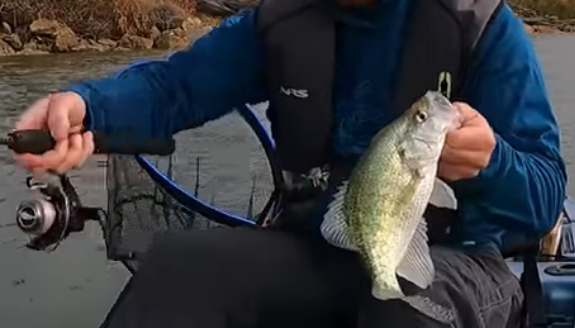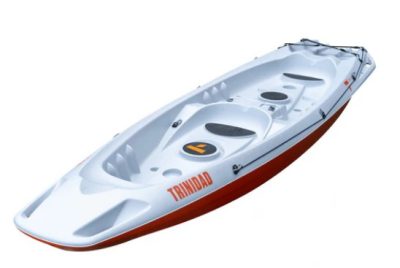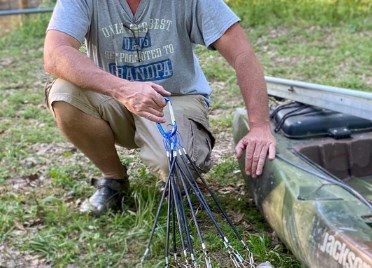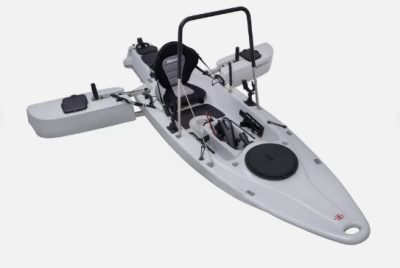Crappie Kayak Fishing
Introduction
Crappie kayak fishing is not just a hobby; it’s a captivating adventure that allows you to connect with nature while enjoying the thrill of angling. As an enthusiast and advisor, I’m delighted to provide you with a comprehensive guide on this exhilarating pursuit, sharing tips and insights that will enhance your crappie kayak fishing experience.
Choosing the Right Kayak for Crappie Fishing
Selecting the perfect kayak is a critical decision that sets the foundation for a successful fishing trip. Your kayak should offer a delicate balance of stability, maneuverability, and storage options. A sit-on-top kayak is an excellent choice, as it provides a stable platform and allows you to move freely, making it ideal for casting and reeling in your catch.
When choosing your kayak, consider the length and width. Longer kayaks tend to track better and offer greater speed, while wider kayaks provide enhanced stability. Choose according to your preference and the conditions you plan to fish in.
Essential Gear and Tackle
To double your chances of a bountiful catch, having the right gear and tackle is paramount. Start with a high-quality fishing rod specially designed for crappie fishing. Ultralight or light-action rods are ideal, offering the sensitivity needed to detect those delicate strikes.
In addition to your fishing rod, it’s crucial to choose the right reel and fishing line. Opt for a reel with a smooth drag system, and consider using fluorocarbon or monofilament line. These lines have excellent strength and low visibility, which can increase your success rate.
Finding the Perfect Crappie Spots
Selecting the right fishing spot is half the battle when it comes to crappie kayak fishing. Crappie exhibit seasonal movements, so understanding their behavior is essential. During the spring, they tend to move to shallower waters for spawning. In summer, they may seek deeper and cooler spots. To become a successful crappie angler, you must adapt to their migratory patterns.
Consider factors such as water temperature, depth, and underwater structure when determining your fishing location. Crappie often congregate around submerged trees, brush piles, and drop-offs. Utilize fish finders or your own observation skills to locate these hotspots.
Bait and Lure Selection
Crappie can be discerning eaters, and your choice of bait and lures plays a pivotal role in your success. Live bait is a top choice for crappie enthusiasts. Minnows, small worms, or insects are all effective options. When using lures, experiment with different colours, sizes, and styles to determine the preferences of crappie in your area. Jigs, soft plastics, and crankbaits are all popular choices.
Remember to maintain a variety of baits and lures in your tackle box to adapt to changing conditions and the specific mood of the fish on any given day.
Techniques for Crappie Kayak Fishing
Becoming a skilled crappie kayak angler involves mastering various techniques. Jigging is a classic method where you use a slight up-and-down motion to attract the fish. Lightly jigging a small jig or minnow under a bobber can be highly effective. Slow trolling and drifting are also productive techniques, especially when crappie are dispersed and not congregated in one area. Experiment with the speed and depth at which you present your bait to find what works best on any given day.
Safety Measures on the Water
Ensuring safety should always be a top priority. When on the water, wear a personal flotation device (life jacket) at all times. Even experienced swimmers should adhere to this rule. Additionally, keep essential safety equipment within easy reach, including a whistle and a paddle leash. Check the weather forecast before embarking on your journey, and always be prepared to return to shore if conditions deteriorate.
Proper safety measures not only protect you but also contribute to a positive and responsible fishing community.
Maintaining Etiquette
Respecting fellow anglers and the environment is crucial. Maintaining good etiquette while crappie kayak fishing ensures an enjoyable experience for all involved. Keep a safe distance from other fishermen to avoid entangling lines or disturbing their catch. Use quiet and discreet voices, and avoid making loud noises that could scare away fish. Moreover, always clean up after yourself by disposing of trash responsibly.
Preserving the beauty of our natural surroundings and promoting a harmonious fishing experience is a shared responsibility.
Adapting to Weather Conditions
Weather conditions can significantly impact your fishing experience. Crappie tend to be more active during overcast days or when there’s a light chop on the water. Be prepared to adapt your strategy based on the prevailing weather conditions. Sunny days may require fishing deeper, while cloudy days might prompt you to move to shallower waters.
Stay attuned to weather forecasts and consider investing in quality rain gear for those unexpected rain showers.
Benefits of Kayak Fishing for Crappie
The appeal of kayak fishing extends beyond the thrill of the catch. It offers a unique connection to nature and allows you to explore waters that might be inaccessible by boat. The silence of the kayak and the tranquility of the open water create an intimate and meditative fishing experience. Additionally, the low environmental impact of kayaks makes them a sustainable and eco-friendly choice for anglers.
Whether you’re a beginner or an experienced angler, kayak fishing provides an opportunity to deepen your connection with nature while pursuing your passion.
My Personal Kayak Setup and Experience
I’ve had countless memorable experiences while crappie kayak fishing, and I’d like to share some of my personal insights. Customizing your kayak to meet your specific needs can significantly enhance your fishing trips. Consider installing accessories like rod holders, fish finders, and comfortable seating. These personal touches can make your time on the water more enjoyable and productive.
Reflecting on my experiences, some of my most unforgettable crappie catches have happened during the early morning hours when the lake is still and calm. Observing the sunrise from my kayak and experiencing the serene beauty of nature while landing a prized crappie is a sensation like no other.
Conclusion
Crappie kayak fishing offers a unique blend of adventure, tranquility, and connection to the natural world. By choosing the right kayak, gear, and mastering effective techniques, you can significantly increase your chances of success while immersing yourself in the great outdoors. So, grab your gear, paddle out, and embrace the world of crappie kayak fishing with enthusiasm and respect.
FAQs
- Is kayak fishing safe for beginners?
- Absolutely! Just ensure you follow safety guidelines, start in calm waters, and gradually build your skills.
- What’s the best time of day to catch crappie from a kayak?
- Early morning and late afternoon are typically the most productive times, but crappie can be caught throughout the day.
- Do I need a fishing license for kayak fishing?
- Yes, you’ll need a fishing license, just as you would for traditional fishing. Make sure to check local regulations for specific requirements.
- How do I choose the right paddle for my kayak?
- Look for a paddle with adjustable length and a blade design suitable for your style of kayaking. Your paddle choice can significantly impact your comfort and efficiency on the water.
- What’s the most challenging aspect of crappie kayak fishing?
- Patience can be a challenge, as crappie are known for their subtlety when striking. Be prepared to wait for the right moment and refine your techniques through practice and experience.




